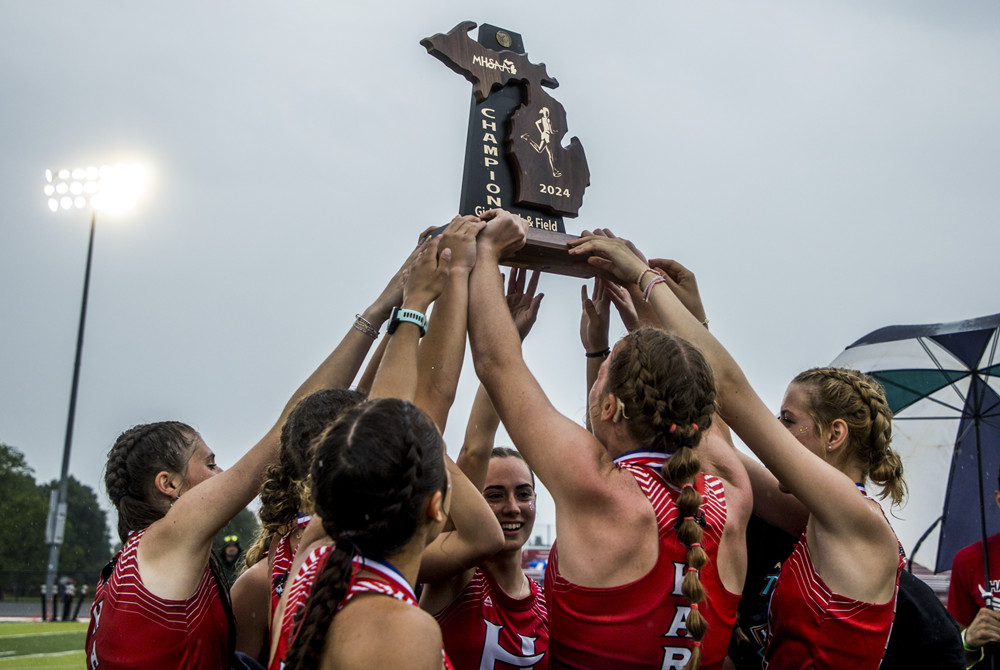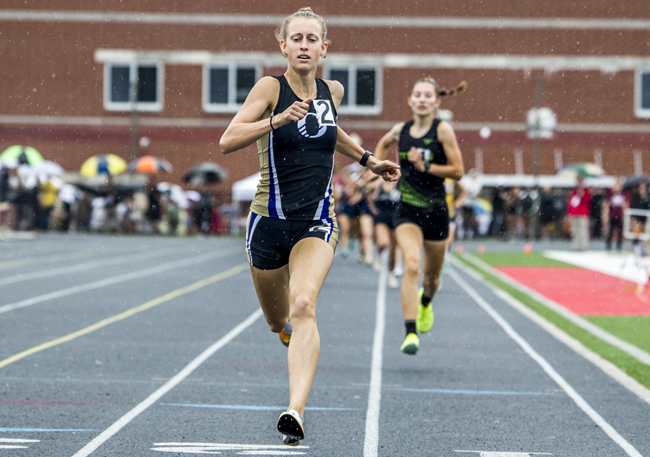
New Math: Division & Multiplication Problems
July 25, 2017
By Jack Roberts
MHSAA Executive Director
This is the second part in a series on MHSAA tournament classification, past and present, that will be published over the next two weeks. This series originally ran in this spring's edition of MHSAA benchmarks.
High school tournament classifications went viral before there was social media and most of us knew what “viral” meant.
Much as a virus infects computers today or has created epidemics of disease around the world for centuries, high school tournament classification – once introduced – tends to spread uncontrollably. Once started, it tends to keep expanding and rarely contracts.
While we are still some distance from providing every team a trophy as a result of expanding high school tournament classification across the country, there is criticism nevertheless that we are headed in that direction – a philosophy which is supposed to exist only in local youth sports for our youngest children.
Michigan could be blamed for all this. Michigan is generally accepted as the first state to provide different classifications for season-ending tournaments for different sized schools. It started a century ago. Today, every state has various classifications for its tournaments in most if not all sports. And it is a bit ironic that Michigan – creator of the classification chaos – more than most other states has kept the number of tournament classes or divisions under control.
Yes, there is evidence that tournament classifications have expanded over the years in Michigan, especially with the relatively recent introduction of tournaments in football and the late 1990s’ move from classes to divisions in most MHSAA tournaments. But the MHSAA Representative Council has held true to its word when it expanded the playoffs for football from four classes to eight divisions: this is needed because of unique factors of football, factors that exist in no other sport; and all other sports should be capped at a maximum of four classes or divisions.
Kentucky is the preeminent defender of single-class basketball. All of its 276 high schools compete for the single state championship for each gender. In Indiana, there are still open wounds from its move in 1998 from one to four classes for its 400 schools in basketball.
Multi-class tournaments have tended to increase the number of non-public school champions, which some states are trying to lower through enrollment “multipliers,” and also tend to increase the number of repeat champions, which some states are trying to affect with “success factors” which lift smaller schools into classifications for larger schools if they take home too many trophies.
While there is considerable evidence that state tournaments do as much bad as good for educational athletics, state associations persist in providing postseason tournaments because, on balance, the experiences are supposed to be good for student-athletes. And once we reach that conclusion it is just a small leap to believe that if the tournaments are good for a few, they must be better for more – which leads to creating more and more tournament classifications. One becomes two classes, then three, then four and so forth.
While the argument is that more classifications or divisions provides more students with opportunities to compete and win, it is undeniable that the experience changes as the number of tournament classifications expands. It is not possible for state associations to provide the same level of support when tournament classifications expand to multiple venues playing simultaneously. For example, there is less audio and video broadcast potential at each venue, and less media coverage to each venue. Focus is diluted and fans diminished at each championship.
No one can argue reasonably that today's two-day MHSAA Football Finals of eight championship games has the same pizazz as the one-day, four-games event conducted prior to 1990.
In some states the number of divisions has grown so much that it is difficult to see much difference between the many season-ending state championship games and a regular-season event in the same sport.
It is a balancing act. And Michigan has been studying that balance longer than any other state, and charting a steadier course than most.
Addition by Division
The shift to Divisions for MHSAA Tournament play in numerous sports has added up to a greater number of champions for teams and individuals across the state. Following are the sports currently employing a divisional format, and the procedures for determining enrollment and classification.
In 23 statewide or Lower Peninsula tournaments, schools which sponsor the sport are currently divided into nearly equal divisions. They are:
- Baseball - 4 Divisions
- Boys Bowling - 4 Divisions
- Girls Bowling - 4 Divisions
- Girls Competitive Cheer - 4 Divisions
- LP Boys Cross Country - 4 Divisions
- LP Girls Cross Country - 4 Divisions
- LP Boys Golf - 4 Divisions
- LP Girls Golf - 4 Divisions
- Ice Hockey - 3 Divisions
- Boys Lacrosse - 2 Divisions
- Girls Lacrosse - 2 Divisions
- Boys Skiing - 2 Divisions
- Girls Skiing - 2 Divisions
- LP Boys Soccer - 4 Divisions LP
- Girls Soccer - 4 Divisions
- Girls Softball - 4 Divisions
- LP Boys Swimming & Diving - 3 Divisions
- LP Girls Swimming & Diving - 3 Divisions
- LP Boys Tennis - 4 Divisions
- LP Girls Tennis - 4 Divisions
- LP Boys Track & Field - 4 Divisions
- LP Girls Track & Field - 4 Divisions
- Wrestling - 4 Divisions
Lists of schools for each division of these 23 tournaments are posted on MHSAA.com approximately April 1. Listings of schools in Upper Peninsula tournaments for their sports are also posted on MHSAA.com. The lists are based on school memberships and sports sponsorships in effect or anticipated for the following school year, as known to the MHSAA office as of a date in early March.
In football, the 256 schools which qualify for MHSAA 11-player playoffs are placed in eight equal divisions annually on Selection Sunday. Beginning in 2017, the 8-player divisions will be determined in a like manner on Selection Sunday as well, with 32 qualifying schools placed in two divisions.
Schools have the option to play in any higher division in one or more sports for a minimum of two years.
The deadlines for "opt-ups" are as follows:
- Applications for fall sports must be submitted by April 15
- Applications for winter sports must be submitted by Aug. 15
- Applications for spring sports must be submitted by Oct. 15
Subsequent to the date of these postings for these tournaments, no school will have its division raised or lowered by schools opening or closing, schools adding or dropping sports, schools exercising the option to play in a higher division, or approval or dissolution of cooperative programs.
When the same sport is conducted for boys and girls in the same season (e.g., track & field and cross country), the gender that has the most sponsoring schools controls the division breaks for both genders.

Hovey Leads Hart to Historic 3-Peat, Onsted's Ross Joins Prestigious 4-Win Group
By
Dean Holzwarth
Special for MHSAA.com
June 1, 2024
KENT CITY – Addison Hovey was a dual threat Saturday for the Hart girls track & field team.
The junior standout used blazing speed, combined with remarkable leaping ability, to help spark the Pirates to a third-straight title at the Lower Peninsula Division 3 Finals, held at Kent City High School.
Hovey captured wins in the 100 and 200, while also winning the high jump for a second straight year.
“Winning high jump was my main priority, and then top eight in the 100 and 200,” Hovey said. “But I’m honestly so surprised because I knew there were really good girls in those two events.
“I’m just really proud of how much work I’ve put in this season, and it showed today and paid off.”
Hart became the first Division 3 girls team to win three consecutive championships. The Pirates finished with 53 points, while Onsted (40) was runner-up and Olivet (38) took third.
“It means the world to me and my team,” Hovey said. “No team in Division 3 had won three years in a row, so that’s huge. We lost one of our really good athletes, and she was a big part for us, so we knew there was going to be some pressure coming into this. I’m really proud of my teammates. The girls stepped up and helped me.”
 Last season’s 3,200 winner, Jessica Jazwinski, was unable to compete for most of this season.
Last season’s 3,200 winner, Jessica Jazwinski, was unable to compete for most of this season.
“I really didn't expect this part way through the season,” Hart coach Calvin Ackley said. “Especially because a couple distance runners, one went out, and one was coming back from injury. Traditionally, we’ve been distance, distance at Hart. I never thought I’d see the day we would be dominating in sprints. That’s been exciting, and my coaches are fantastic.”
Hovey out-jumped Kalamazoo Christian’s Ellie VanDusen by eclipsing 5-foot-6 to tie the LPD3 Finals record. Hovey also recorded a personal-best time of 12.27 in the 100 and ended her day with an impressive 25.60 in the 200.
“I was so tired, but I just gave it my all,” Hovey said. “It was the last event of my last meet. Hopefully I feel better tomorrow.”
Ackley said Hovey’s improvement over the past few years has been remarkable.
“Absolutely amazing day,” he said. “She’s come a long way from a freshman kind of unsure of herself to an absolute beast.
“She’s an amazing athlete and has a great attitude. She doesn't worry about the little things that don't matter. She just focuses on what she needs to do, and she carried the team today. She just keeps progressing, and she’s a great basketball player, but a fantastic track athlete.”
Junior Emmry Ross also shined, winning all four of her events to single-handedly place Onsted second as a team. She racked up repeat victories in the 400 and 800, while also claiming titles in the 1,600 and 3,200 – becoming just the seventh girl all-time (and third in the Lower Peninsula) to win four events at an MHSAA Finals.
“Honestly, I went into today pretty nervous,” Ross said. “I was more nervous last night than I was today because today I just went in with the mindset of, ‘Do my best. You got here. You deserve this.’ I worked really hard this season, and I just went in and had confidence. It turned out to be a really good day, and it was fun because I got to run in the rain.”
Ross said running four events wasn’t grueling because of her preparation.
“I train for it,” she said. “I ran those four (events) at Regionals and two other meets before that, so I was used to it. It wasn’t a challenge because I’ve done it before.”
While those two combined to win the majority of Saturday’s individual running events, Kalamazoo Christian freshman Elli VanDusen (110 hurdles) and Olivet sophomore Emily Peters (300 hurdles) claimed titles as well. Monroe St. Mary Catholic Central (400), Olivet (800) and Jackson Lumen Christi (1,600 and 3,200) won the relays. Montrose freshman Addyson Stiverson (shot put) and Grayling senior Rylan Finstrom (discus) were first in the throws, Wyoming Potter’s House Christian junior Sohanny Gonzalez-Castillo won the long jump and Homer junior Emma Wildt won the pole vault.
PHOTOS (Top) Hart celebrates its third-straight Division 3 championship Saturday at Kent City. (Middle) Onsted’s Emmry Ross crosses the finish line for one of her four individual victories. (Click for more from Jamie McNinch/RunMichigan.com.)

